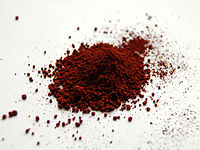Ferric oxide
 |
|
 |
|
 |
|
| Names | |
|---|---|
|
IUPAC name
Iron(III) oxide
|
|
| Other names | |
| Identifiers | |
|
1309-37-1 |
|
| 3D model (Jmol) | Interactive image |
| ChEBI |
CHEBI:50819 |
| ChemSpider |
14147 |
| ECHA InfoCard | 100.013.790 |
| EC Number | 215-168-2 |
| E number | E172(ii) (colours) |
| 11092 | |
| KEGG |
C19424 |
| PubChem | 518696 |
| RTECS number | NO7400000 |
| UNII |
1K09F3G675 |
|
|
| Properties | |
| Fe2O3 | |
| Molar mass | 159.69 g·mol−1 |
| Appearance | Red-brown solid |
| Odor | Odorless |
| Density | 5.242 g/cm3 |
| Melting point | 1,539–1,565 °C (2,802–2,849 °F; 1,812–1,838 K) decomposes 105 °C (221 °F; 378 K) β-dihydrate, decomposes 150 °C (302 °F; 423 K) β-monohydrate, decomposes 50 °C (122 °F; 323 K) α-dihydrate, decomposes 92 °C (198 °F; 365 K) α-monohydrate, decomposes |
| Insoluble | |
| Solubility | Soluble in diluted acids,sugar solution Trihydrate slightly soluble in aq. tartaric acid, citric acid, CH3COOH |
| +3586.0·10−6 cm3/mol | |
| Structure | |
|
Rhombohedral, hR30 (α-form) Cubic bixbyite, cI80 (β-form) Cubic spinel (γ-form) Orthorhombic (ε-form) |
|
| R3c, No. 161 (α-form) Ia3, No. 206 (β-form) Pna21, No. 33 (ε-form) |
|
| 3m (α-form) 2/m 3 (β-form) mm2 (ε-form) |
|
| Octahedral (Fe3+, α-form, β-form) | |
| Thermochemistry | |
| 103.9 J/mol·K | |
|
Std molar
entropy (S |
87.4 J/mol·K |
|
Std enthalpy of
formation (ΔfH |
−824.2 kJ/mol |
|
Gibbs free energy (ΔfG˚)
|
−742.2 kJ/mol |
| Hazards | |
| GHS pictograms |  |
| GHS signal word | Warning |
| H315, H319, H335 | |
| P261, P305+351+338 | |
|
EU classification (DSD)
|
|
| R-phrases | R36/37/38 |
| S-phrases | S26 |
| NFPA 704 | |
| 5 mg/m3 (TWA) | |
| Lethal dose or concentration (LD, LC): | |
|
LD50 (median dose)
|
10 g/kg (rats, oral) |
| US health exposure limits (NIOSH): | |
|
PEL (Permissible)
|
TWA 10 mg/m3 |
|
REL (Recommended)
|
TWA 5 mg/m3 |
|
IDLH (Immediate danger)
|
2500 mg/m3 |
| Related compounds | |
|
Other anions
|
Iron(III) fluoride |
|
Other cations
|
Manganese(III) oxide Cobalt(III) oxide |
|
Related iron oxides
|
Iron(II) oxide Iron(II,III) oxide |
|
Except where otherwise noted, data are given for materials in their standard state (at 25 °C [77 °F], 100 kPa).
|
|
|
|
|
| Infobox references | |
Iron(III) oxide or ferric oxide is the inorganic compound with the formula Fe2O3. It is one of the three main oxides of iron, the other two being iron(II) oxide (FeO), which is rare, and iron(II,III) oxide (Fe3O4), which also occurs naturally as the mineral magnetite. As the mineral known as hematite, Fe2O3 is the main source of iron for the steel industry. Fe2O3 is ferromagnetic, dark red, and readily attacked by acids. Iron(III) oxide is often called rust, and to some extent this label is useful, because rust shares several properties and has a similar composition. To a chemist, rust is considered an ill-defined material, described as hydrated ferric oxide.
Fe2O3 can be obtained in various polymorphs. In the main ones, α and γ, iron adopts octahedral coordination geometry. That is, each Fe center is bound to six oxygen ligands.
α-Fe2O3 has the rhombohedral, corundum (α-Al2O3) structure and is the most common form. It occurs naturally as the mineral hematite which is mined as the main ore of iron. It is antiferromagnetic below ~260 K (Morin transition temperature), and exhibits weak ferromagnetism between 260 K and the Néel temperature, 950 K. It is easy to prepare using both thermal decomposition and precipitation in the liquid phase. Its magnetic properties are dependent on many factors, e.g. pressure, particle size, and magnetic field intensity.
...
Wikipedia

